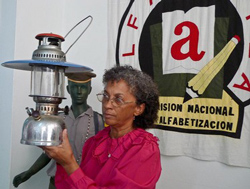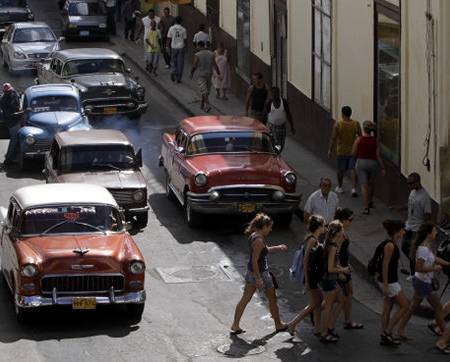
The Column of Lasting Insignificance: April 30, 2011
John Wilcock
Cuba Diary (part one)
Havana, April 2011
SUNDAY: Barely off the bus from the airport, we checked our bags at the Hotel Vedador and headed for Callejón de Hamel where Cliff DuRand, our tour director, said there was a high-octane musical scene taking place only on Sunday afternoons. It was pretty wild, a dozen Rasta-style drummers beating out a feral furor of Afro-Cuban rumba rhythms surrounded by a raucous crowd of predominantly black enthusiasts who crammed the one-block backwater. Old bathtubs had ingeniously been created into seats and also served as wall panels painted — improbably — with scenes from Antoine De Saint-Exupery’s The Little Prince.
How appropriate this frenzied fandango should be our introduction to the country. “Music in Cuba,” wrote Jory Farr, “is not merely art. Fire and water, blood and seed, poetry and mystery, music is the high road to initiation, a shaking and breaking of the soul.”
The sole Black member of our group, an impressively tall Atlanta teacher named Sandra, split with me early to walk back to the hotel. I felt safer in this slightly nervy neighborhood, I joked, because people might think we were married.

It might seem surprising that in a country with such high ideals of the brotherhood of man, that racism could still be a factor, but Cuba is no more exempt from this ancient bias than other places. For generations, Blacks and their descendants occupied the lowest rung in Cuban society, says Esteban Morales Dominguez, a University of Havana professor. “We cannot expect that in a mere half-century since its triumph, the Revolution could fully lift them out of their situation of inferiority,” he wrote. “ Racism is a very complex, multi-dimensional, and multi-causal matter that does not disappear solely through achievement of higher levels of social justice.”
MONDAY: Unaware that clocks had been moved forward a further hour, I got down to breakfast late but still before the scheduled 9:30 departure. Recognizing a pair from the tour group, I left my bag at their table and went to the buffet, returning to find them gone. A few minutes later I discovered the tour group had left without me, and when I saw the couple later I taxed them with not warning me they had been about to leave. Both flatly denied they had ever seen me before.
What I had missed was the orientation session, some of whose information Cliff had earlier outlined in a memo. One detail was that the US embargo meant that credit cards or travelers’ checks drawn on US banks — or even US-owned foreign banks — were unusable and that a 10% surcharge was imposed on the exchange of US dollars. “This is because the US Treasury Department has made it difficult for Cuba to use dollars in its international trade. So the 10% is to cover the extra expenses in getting around that harassment by the US. Think of it as an extra tax we have to pay for our government’s embargo,” he explained.
The US also barred Cuban access to the cable running under the Gulf, so internet is via satellite which is both slow and costly. How petty and spiteful the Feds have acted towards its little neighbor. Currently, about 3% of Cubans use the Internet but this will probably change when a new fiber optic link from Venezuela is completed. Access is currently barred in most private homes, censored in offices, but many Cubans bypass curbs by buying access from doctors, senior managers, and academics who have legal connections.
Photography was barred during our afternoon visit to the majestic former presidential palace that is now the Museum of the Revolution. No big surprises though: ancient carriages, guns, the engine of a US plane shot down during the 1997 Missile Crisis, former dictator Fulgencio Batista’s gold-plated telephone. Behind the Museum apparently, in a glass case which I failed to see, is the ancient yacht Granma which carried Fidel and his 82 fellow revolutionaries from Mexico to Cuba in 1956.
Wandering the back streets near the hotel I discovered a little mercado which, while cheap, had very meager fare: canned peaches, tomato soup, and mystery meat from China, salted crackers, frozen pork, and beef. No fruit or vegetables. And no bags either; customers must bring their own and so even handing over an old plastic bag to a man struggling to hold half a dozen items was received with gratitude.
In one of his essays, a frequent visitor to the country Richard Levins repeated what he said was an old joke in Cuba, that all economic plans are over-fulfilled, “but the stores are empty. The stores are empty but people have what they need. They have what they need but they all complain. They all complain, but they are all Fidelistas.”
There are shortages of everything. The maid in my hotel was grateful for such surplus items in my bag as scotch tape, aspirins, a T-shirt. Pens are a popular giveaway; the very few beggars I encountered smiled when I handed them out (I carried a score of them, collected from my bank over past months.) Of course, there are homeless — could there be a country without any? — but they’re obviously not seen in areas where tourists are apt to go. The overall impression that comes through is how millions of people cope when they are deprived of almost everything except essentials, and how mean-spirited it is of some Americans to criticize them for the very faults that America has caused, or at least magnified. Cuba, a threat to the US? Get real.
TUESDAY: A meeting to learn about the country’s health system which, covering everyone, is something of a triumph. Apart from offering virtually free treatment to all, the state has dispatched hundreds of doctors to dozens of poor countries, often picking up the tab and, via its Latin American School of Medicine, gives free medical educations to hundreds of poor youth from elsewhere in Latin America, Africa and even the U.S. The sole stipulation is that graduates return to their own poor areas to practice medicine for the people. When the 1,610 students of the first class graduated this year, Castro told them that this sort of “human capital” was more valuable than financial capital. “Human capital,” he said, “ involves not only knowledge, but also – and this is essential – conscience, ethics, solidarity, truly humane feelings, spirit of sacrifice, heroism, and the ability to make a little go a long way.”
It’s becoming increasingly clear that, bullied by its big neighbor for half a century, Cubans have definitely learned to make a little go a long way.
The lecturer, Dr. Portilla, went at his subject with gusto and had some impressive statistics available. Cuba has more doctors per capita than any other country in the world, for example, and its infant mortality rate, 5.9 deaths per thousand is lower than that of the US. It has 450 doctors donating their services to Haiti; others working in poor neighborhoods in Venezuela. President Castro even offered to send 1,500 doctors to the U.S. in response to the hurricane Katrina emergency. The Bush administration turned him down.
On all our trips, we are accompanied by the charming Linett, an official guide and translator with a captivating manner and a virtually permanent smile. I quickly discovered that even if I was too far away from the group (probably videotaping) to hear what she was saying, that her expansive hand and arm gestures conveyed the picture even better than her impeccable English.
After dinner at Havana’s San Carlos de la Cabana Fort, we watched the nightly drama in which a platoon of 19th c. soldiers perform about 20 minutes of a slightly repetitive ritual, involving mucho marching and shouting, before the firing of an ancient cannon. The resulting puny bang is said to represent a ceremony performed in ancient times to symbolize the city’s gates being closed for the night.
WEDNESDAY: A bus picks us up each morning to ferry us to the next engagement, and sitting next to Cliff who was wearing a University of Havana T-shirt (he teaches there part-time) I asked him if the boast about Cuba’s much-vaunted education system was justified.
“Well, free education is a good start,” he said. “That happens right through university, graduate, and professional levels and, as a result, Cuba today has the most highly-educated and technically trained population in Latin America. This high quality has certainly been noticed by the US students I have brought there in recent years. They’ve been blown away by the university students they’ve met with. They have found them better informed, more articulate, and better able to reason than most of their US friends, and that’s certainly not what they expected to find in an ’underdeveloped’ society.”
Our ultimate destination today was the graceful mansion housing the José Marti Cultural Society, whose garden displayed a sculpture of the revered, 19th-century revolutionary philosopher, writer, and publisher who fought tirelessly for Cuban independence (from both Spain and the U.S.).
But the ensuing lecture, in an undersized room filled with the buzzing of a loud air conditioner, was poorly organized. During a talk billed as “the economic transformation of Cuban society,” a clearly knowledgeable lady amplified point after point projected onto a screen — in Spanish. A translator followed up each sentence in English, but with the combination of failing hearing and the background hum, I couldn’t understand a word. Of course, if the slides had been in English….
I never caught up on that particular lecture but in my pre-tour homework I had absorbed an important point which was that when the Revolution had been won and both Batista and the Mafia goons and the rip-off multinationals who dominated the country had been expelled, the country’s new leaders felt that socializing the economy was the only way to break the fiscal and political stranglehold. A joke from those days — clearly apocryphal — had Castro meeting with a group, drawing a line in the sand and asking everybody to step to one side or the other, thus voting for whether the country should take the capitalist or socialist road. One man straddled the line and said he couldn’t make up his mind. “Ah,” said Fidel. “Then you’d better come and join the Central Committee.”
Back at the hotel, there was just time for a swim. In the Vedado’s large and attractive pool, where a small snack bar offers delicious tuna fish sandwiches ($2.50) and first-rate Bucanero beer ($2). The dollar and peso are at par and everybody patronizes the lobby bar to buy $1 bottles of water or espresso for the same price.
In the afternoon, it was off again by bus to the City of Liberty, a somewhat rundown complex originally the headquarters of the dictator Batista’s army and later used to re-educate these demobilized soldiers after the revolution. Part of the re-education was the national project that the new regime set up to abolish illiteracy, and the story is an interesting one. Havana’s Literacy Museum celebrates the genuine achievement of the country’s 1961 program which reduced illiteracy from 42% to 4% within a few years. Almost 300,000 teachers, half of them women and some barely out of school themselves, fanned through the country teaching millions to read, 700,000 in the first year. Some of the teachers were murdered by counter-revolutionaries and their pitiful possessions are among the items preserved.

Luisa, the scrappy bespectacled curator, her face wrinkled as a walnut, talked glowingly of this proud record, illustrating her talk by holding up flags, banners, and a Chinese lantern of the kind used in the dark, mountain hamlets before conducting us through the simple, one-storey building, filled with shelves of books and glass cases containing photographs and manuals. Many showed scenes in remote villages where teachers had instructed their mostly young pupils, some of whom had been given their very first eye examinations and offered free glasses.
As daylight faded, I walked three blocks down to the Malecon, the waist-high concrete wall separating the sea from the six-lane boulevard running the length of the city. At first, I was puzzled at the absence of street signs until I realized that they were marked on miniature concrete pyramids at sidewalk level on every corner. The side streets were quiet, but along the Malecon, traffic never stops, a constant stream of all kinds of cars — many the decrepit pre-Revolutionary models for which Cuba is famed, but sleek modern cars, too, most provided to their employees by foreign companies that have opened businesses here. And because traffic never stops, just crossing the boulevard is something of a hazard, but once across, the wall is always occupied by people. On the far side, many of the magnificent old mansions are being renovated. When my friend Stephen Mansfield visited a few years ago he wrote in the Ojai Orange:
“Havana’s architecture elicits surprise, awe, and sadness. Here the poor live in the very center of the city, behind decaying rococo and Art Deco facades, watching their Spanish and neo-classical buildings, high-ceilinged rooms and trompe l’oeil interiors dissolve into the solution of neglect. Steel reinforcements poke through plaster columns, cornices sag, weeds take root in the cracks of cement porches, window frames peel and curtains become mildewed in the tropical heat.”
|
|
{ To be continued next week }

